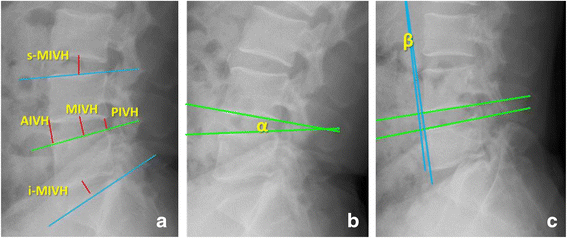Analysis of the correlative factors in the selection of interbody fusion cage height in transforaminal lumbar interbody fusion
- PMID: 26754610
- PMCID: PMC4709994
- DOI: 10.1186/s12891-016-0866-5
Analysis of the correlative factors in the selection of interbody fusion cage height in transforaminal lumbar interbody fusion
Abstract
Background: Selecting an interbody cage with appropriate height is one of the key steps in lumbar interbody fusion, and has an important impact on clinical efficacy. How to choose the appropriate height of the cage becomes one of the core problems of lumbar interbody fusion for spine surgeons. However, studies about objective selection criteria on interbody cage height was rare.
Methods: One hundred fifty-seven patients with single segment lumbar degenerative diseases treated by TLIF surgery from January 2011 to July 2013 were retrospectively analyzed. Parameters analyzed included: gender, age, body height, clinical diagnosis, pathological segment location and the intervertebral height of pathological segment, pathological segment activity, the intervertebral height of the adjacent segments. And further to analyze the correlation between these parameters and interbody cage height. By measuring the intervertebral height of pathological segment and normal segment to calculate the regression equation of interbody cage height.
Results: The average interbody cage height of male patients (12.38 ± 1.43) mm was significantly higher than female (11.62 ± 1.45) mm (p < 0.001). The L4-5 segment interbody cage height (12.11 ± 1.38) mm was significantly greater than the L5-S1 (11.25 ± 1.32) mm (p = 0.04). Body height, the intervertebral height of pathological segment, and the middle intervertebral heigh of upper adjacent segment were highly positively correlated to the interbody cage height. The range of interbody cage height used in transforaminal lumbar interbody fusion for Chinese patients with lumbar degenerative diseases was: L3-4 (11.28 ± 3.29) mm ~ (12.76 ± 2.40) mm, L4-5 (11.62 ± 2.89) mm ~ (13.18 ± 1.91) mm, L5-S1 (10.52 ± 2.22) mm ~ (11.90 ± 2.80) mm. The regression equation of interbody cage height was: interbody cage height = 11.123-0.563 * (gender) + 0.149 * (the middle intervertebral height of pathological segment).
Conclusions: The selection of interbody cage height was influenced by sex, body height, pathological segment location, the intervertebral height of pathological segment and other factors. The interbody cage height for the lower lumbar spine mostly selected 11,12,13 mm, L3-4, L4-5 segment highly selective in general should not be less than 10 mm, and L5-S1 segments height was relatively small, usually not more than 13 mm. The interbody cage height might be selected based on the regression equation of interbody cage height. But, the regression equation maybe need to be verified in a prospective study.
Figures

References
-
- Groff MW, Dailey AT, Ghogawala Z, Resnick DK, Watters WC, 3rd, Mummaneni PV, Choudhri TF, Eck JC, Sharan A, Wang JC, Dhall SS, Kaiser MG. Guideline update for the performance of fusion procedures for degenerative disease of the lumbar spine. Part 12: pedicle screw fixation as an adjunct to posterolateral fusion. J Neurosurg Spine. 2014;21:75–78. doi: 10.3171/2014.4.SPINE14277. - DOI - PubMed
-
- Mummaneni PV, Dhall SS, Eck JC, Groff MW, Ghogawala Z, Watters WC, 3rd, Dailey AT, Resnick DK, Choudhri TF, Sharan A, Wang JC, Kaiser MG. Guideline update for the performance of fusion procedures for degenerative disease of the lumbar spine. Part 11: interbody techniques for lumbar fusion. J Neurosurg Spine. 2014;21:67–74. doi: 10.3171/2014.4.SPINE14276. - DOI - PubMed
-
- Noshchenko A, Hoffecker L, Lindley EM, Burger EL, Cain CM, Patel VV. Perioperative and longterm clinical outcomes for bone morphogenetic protein versus iliac crest bone graft for lumbar fusion in degenerative disk disease: systematic review with meta-analysis. J Spinal Disord Tech. 2014;27(3):117-35. - PubMed
Publication types
MeSH terms
LinkOut - more resources
Full Text Sources
Other Literature Sources

